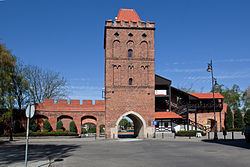Town rights 1255 Area 20.96 km² Local time Friday 2:35 AM | Established 13th century Elevation 150 m (490 ft) Population 36,951 (2006) | |
 | ||
Weather 6°C, Wind NW at 11 km/h, 91% Humidity Voivodeship Lower Silesian Voivodeship | ||
Oleśnica [ɔlɛɕˈɲit͡sa] (German: Oels) is a town in Lower Silesian Voivodeship, in south-western Poland. From 1975–1998 it was in former Wrocław Voivodeship. It is the administrative seat of Oleśnica County and also of the rural district of Gmina Oleśnica, although it is not part of the territory of the latter, the town being an urban gmina in its own right.
Contents
Map of Olesnica, Poland
Name
The town's name comes from Polish olsza ("Alder"); Olcha is an Old Slavic word for this common plant and tree. On 22 February 1255 the Silesian duke Henry III the White, son of the Polish High Duke Henry II the Pious, vested civitas nostra Olsnicz ("our town Oleśnica") with town privileges.
Geography
The town is situated in the Silesian Lowlands east of the Trzebnickie Hills, part of the historical region of Lower Silesia. Located about 30 kilometres (19 mi) northeast of the Silesian capital Wrocław, it has been a stop on an important trade route to the Greater Poland region, Kalisz, Łódź and Warsaw; it had close ties with Kraków via Namysłów in the east. It was the site of an important printing press and gymnasium. From the 13th century, it had a coin mint.
The town quarters are Centrum, Serbinów, Lucień, Lucień Osiedle, Wądoły, Rataje (Stare, Nowe) and Zielone Ogrody.
History
The Piast castle with a nearby abbey and trading settlement was first mentioned in an 1189 deed. From the 13th century onwards, the area was largely settled by Germans in the course of the Ostsiedlung. From 1320/21 the former castellany served as the residence of the Piast duke Konrad I of Oleśnica; his son Duke Konrad II the Gray also inherited Koźle. The Duchy of Oleśnica, a Bohemian fief since 1327, was ruled from the town until the 1492 death of Duke Konrad X the White, last of the local Piasts.
The duchy was sold to Duke Henry I of Münsterberg, son of the Bohemian king George of Poděbrady. His grandson Duke John of Münsterberg-Oels established a gymnasium at Oels in 1530. When the Podiebrad family became extinct in 1647, town and duchy were inherited by the Swabian dukes of Württemberg, and in 1792 by the Welf dukes of Brunswick-Lüneburg.
As Oels, the town was annexed by the Kingdom of Prussia in 1742 during the First Silesian War and administered within the Province of Silesia. Following administrative reform in 1807 during the Napoleonic Wars, Oels became the seat of Landkreis Oels. The city became part of the German Empire in 1871 during the Prussian-led unification of Germany.
After World War I, Oels was included within the Province of Lower Silesia. It was heavily damaged by the Red Army in 1945 during World War II, having approximately 60-80% of its buildings destroyed. The city was placed in Poland's borders after the Potsdam Conference and its official name became Oleśnica. The remaining German-speaking population was subsequently expelled and resettled with Poles many of whom were expelled from Eastern Poland annexed in 1945 by the Soviet Union. Several monuments of the former residence have been rebuilt since the 1960s.
Notable people
Twin towns
Oleśnica is twinned with:
